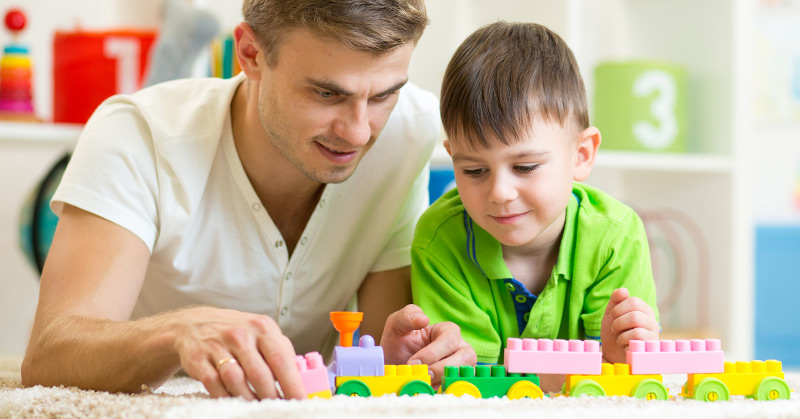As the spooky season ends, the holiday season begins. For people on top of their game, that means they start of gift shopping. If you’re shopping for kids or a parent in general, this new report from the American Association of Pediatricians (AAP) will help your decision on what present is most beneficial for the little ones. Surprisingly, there’s no product with a screen or battery on the list.
“The Best Toys Go Back to the Basics”

As technology advances, we tend to label it as “smart” like with smartphones, smart cars, etc., but that doesn’t mean electronics are a smart choice for children. While toy aisles are filled with screens, music, flashing lights, and voice boxes, the best toys for development are the simplest ones like blocks, balls, and dolls. “Toys have evolved over the years, and advertisements may leave parents with the impression that toys with a ‘virtual’ or digital-based platform are more educational,” Aleeya Healey, MD, FAAP, lead author of the report, stated in the AAP press release. “Research tells us that the best toys need not be flashy or expensive or come with an app. Simple, in this case, really is better.”
For young kids, playtime is a serious business.

Their toys help stimulate their development so it’s imperative to play with things that encourage social behavior and stimulate language and problem-solving skills. This is easily achieved with blocks or baseball mitts with balls, but screens and digital toys tend to isolate children and keep them inactive. “The best toys are those that support parents and children playing, pretending and interacting together,” said Alan Mendelsohn, MD, FAAP, co-author of the report and associate professor in the Departments of Pediatrics and Population Health at NYU Langone Health.
“You just don’t reap the same rewards from a tablet or screen. And when children play with parents — the real magic happens, whether they are pretending with toy characters or building blocks or puzzles together.” Many fancy, “techy” toys are advertised to be educational, but they may not compare to the basic toys that encourage imagination and communication between the child and their friends and family. For the most part, these “educational” toy claims are not based on scientific evidence. “The more we know about early brain development, the more we understand the need for play that is based on human interaction,” Dr. Healey said. “There is no screen, video game, or app that can replace the relationships built over toys.” [1]
How to Choose the Best Toys for Children

The report gives specific tips on how to choose the best toy for a child. Avoid:
- Overstimulating toys
- Toys that promote gender or race stereotypes
- Toys that don’t foster human interaction
Instead, look for toys that encourage:

- Creativity
- Interpersonal play
- Imaginative play
- Socio-emotional development
- Literacy
- Math and spatial skills
Here are some traditional toys children enjoy:

- Dolls and action figures
- Cooking/food toys
- Toy cars
- Blocks
- Puzzles
- Toy trains
- Art supplies
- Board games
- Card games
- Toy letters
- Tricycles and bikes
- Balls
- Push and pull toys
Here are examples of modern toys that don’t promote developmental skills:

- Tablets
- Laptops
- Screens
- Phones
- Electronic games
- Toys with lights and sounds
- Toys that negate human interaction, such as a stuffed animal that reads the story
These traditional toys grow with the child. While a toddler might stack blocks and knock them down to develop their fine motor skills, older kids can build houses for their action figures to live in. Playing imaginary games also promotes language and emotional skills. [2]
Limit Screen Time

The report concluded with a reminder to parents of their current guidelines: children under two shouldn’t be watching screens at all, and children over two should watch less than an hour a day. During screen time, an adult should supervise to ensure the program is educational and age-appropriate. A 2013 study showed that 38% of American children younger than two-years-old have used electronic media devices, as have 80% of two- to four-year-olds. This number has doubled since 2011. Data in 2015 suggests that 96.9% of children had started using mobile devices before age one. This brings negative effects to the children’s development and interactions with their parents and siblings.
Risks of Exposure

Risks of electronic media exposure include obesity and the promotion of aggressive behavior, which occurs when violent acts are justified in context and can desensitize a child to its consequences. For parents and caregivers, it’s important to note that playtime does not have to be educational; it should facilitate warm, supportive relationships between the child and their family members and friends. Meaning, it’s extremely beneficial for children to play with their parents, rather than the parents letting the kids play alone. “The more we know about early brain development, the more we understand the need for play that is based on human interaction,” Dr. Healey said. “There is no screen, video game, or app that can replace the relationships built over toys.”
Sources
- Sarah Aswell. Scary Mommy. Pediatricians Say Kids Need Simple Toys, Not iPads And Electronics https://www.scarymommy.com/aap-statement-toys-electronics/ December 5, 2018
- Aleeya Healey, Alan Mendelsohn and Council on Early Childhood. The American Academy of Pediatrics Selecting Appropriate Toys for Young Children in the Digital Era. https://pediatrics.aappublications.org/content/early/2018/11/29/peds.2018-3348 December 2018

